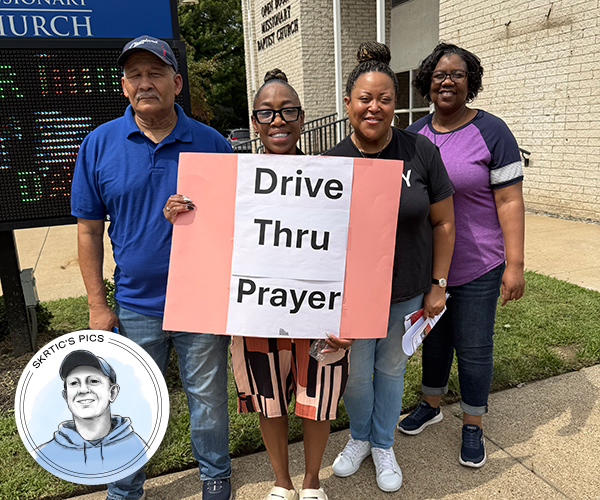Give a wedding toast
Both on the campaign trail and in office, Cleveland Mayor Frank Jackson relied on former special assistant Jason Wood to write speeches that stir emotions. Outside the political world, Wood has helped several friends craft wedding toasts and been a best man himself. So we asked his advice for delivering a heartfelt toast.
[Do] Organize your speech. “Know what you want to talk about and how you want to end the speech. If you know what you want to say in the beginning and the end, the middle will take care of itself.” Know your audience. If you’re at a wedding with a lot of older people, you probably don’t want to tell off-color jokes. “I havefound the best speeches are funny but still touch on emotional aspects.”
[Don’t] Get drunk before the speech. “Maybe a few beers, but not a whole lot.” Wingit. “I wouldn’t go up there without giving your speech any thought. You don’t want to be drinking in the limo and then start worrying about your speech.” Be scared. Instead, be confident and have fun. “You’re a small part of an important day, and people are going to remember the beautiful bride probably more than the speech you gave.”
Both on the campaign trail and in office, Cleveland Mayor Frank Jackson relied on former special assistant Jason Wood to write speeches that stir emotions. Outside the political world, Wood has helped several friends craft wedding toasts and been a best man himself. So we asked his advice for delivering a heartfelt toast.
[Do] Organize your speech. “Know what you want to talk about and how you want to end the speech. If you know what you want to say in the beginning and the end, the middle will take care of itself.” Know your audience. If you’re at a wedding with a lot of older people, you probably don’t want to tell off-color jokes. “I havefound the best speeches are funny but still touch on emotional aspects.”
[Don’t] Get drunk before the speech. “Maybe a few beers, but not a whole lot.” Wingit. “I wouldn’t go up there without giving your speech any thought. You don’t want to be drinking in the limo and then start worrying about your speech.” Be scared. Instead, be confident and have fun. “You’re a small part of an important day, and people are going to remember the beautiful bride probably more than the speech you gave.”
Fake your way through a fancy dinner
{ first course } Take your seat.
Place cards are common at large dinners, but what to do at intimate formal meals? Instead of guests circling to find seats, Baroness Maria von Alvensleben of Rocky River, who teaches young and old alike conduct for state-level dinners through her company, the Silver Spoon, offers some traffic control:
1) At dinner parties of eight or fewer, the host and hostess sit at the table ends, with guests in the middle.
2) At larger, single-table gatherings, the host and hostess will sit across from each other in the middle of the table. The most important woman at the dinner will sit at the right hand of the host, the most important man at the hostess’s right.
{ second course } Silverwhere?
Forks and knives and spoons, oh my! As the courses pass, work from the outside toward the plate. Save the utensils above your place setting for dessert. Oh, and that crazy trowel knife with a notch in its blade? That’s for the fish course, von Alvensleben says, which usually comes third.
2) At larger, single-table gatherings, the host and hostess will sit across from each other in the middle of the table. The most important woman at the dinner will sit at the right hand of the host, the most important man at the hostess’s right.
{ second course } Silverwhere?
Forks and knives and spoons, oh my! As the courses pass, work from the outside toward the plate. Save the utensils above your place setting for dessert. Oh, and that crazy trowel knife with a notch in its blade? That’s for the fish course, von Alvensleben says, which usually comes third.
{ third course } Follow their lead.
Stumped on what comes next? Employ a “fake it till you make it” strategy, she says. Smile. Make small talk. Watch your neighbors for clues. It worked for von Alvensleben years ago when she was stumped by an intimidating utensil and plate of shiny stones — they turned out to be escargot. “We all have that first occasion that we never forget,” she says of learning in the field. “It’s stressful, and it need not be.”
Stumped on what comes next? Employ a “fake it till you make it” strategy, she says. Smile. Make small talk. Watch your neighbors for clues. It worked for von Alvensleben years ago when she was stumped by an intimidating utensil and plate of shiny stones — they turned out to be escargot. “We all have that first occasion that we never forget,” she says of learning in the field. “It’s stressful, and it need not be.”
Diffuse a hostile situation
Whether you’re negotiating with a gunman or trying to calm an irate customer, there is a common theme:You have a potentially explosive situation on your hands, and it’s in your best interest to defuse it quickly. Ron Stollar, a former officer with the Medina Police department who spent 12 years as an FBI-certified crisis negotiator, offers some advice.
> Listen. Stollar, who’s dealt with barricaded homes and hostage standoffs, says everyone involved in a hostile situation needs to just listen to the other person. “Everybody —it’s just human nature — wants to be heard. Once a person believes they have been heard, they feel better to move forward.”
> Repeat. Once the other person tells you his concerns, summarize them and repeat them back so you are both on the same page. “Don’t move forward until you agree with each other.”
> Win. If you engineer an outcome where one side feels like it has lost, “You’re really setting yourself up for failure.” The key is to minimize unhappy feelings and to let people know that, in the end, you’re there for them. “What most people want is some sort of help. You want to give people hope.”
> Listen. Stollar, who’s dealt with barricaded homes and hostage standoffs, says everyone involved in a hostile situation needs to just listen to the other person. “Everybody —it’s just human nature — wants to be heard. Once a person believes they have been heard, they feel better to move forward.”
> Repeat. Once the other person tells you his concerns, summarize them and repeat them back so you are both on the same page. “Don’t move forward until you agree with each other.”
> Win. If you engineer an outcome where one side feels like it has lost, “You’re really setting yourself up for failure.” The key is to minimize unhappy feelings and to let people know that, in the end, you’re there for them. “What most people want is some sort of help. You want to give people hope.”
| Send a Drink Properly You spot a hot prospect at the bar, someone who looks interesting — and, as we said, is damn hot. You want to send him or her a drink without looking creepy. We turned to bartender Rob Turek, who works at Traffic Nightclub.
1 Befriend the bartender, a convenient, non-partisan middleman in any drink-buying transaction. “The bartender is your liaison if you are uncomfortable introducing yourself to the person.” 2 Find out what the other person is drinking. Ask the bartender what your interest is sipping on. “Then your bartender can say, ‘Would you like another apple martini, courtesy of this gentleman?’ ” 3 Gauge the reaction. A smile is a good sign. A smile and wave is better. Ideally, the recipient will approach you to say thanks. Just wait and see. “If you are confused about the person’s reaction, ask the bartender.” 4 Still no reaction? Don’t push it. “I’ve had girls ask me to act like their boyfriend if they’re turned off and guys are bugging them all night.” 5 Tip the bartender. “If you are being a good customer, the bartender will go out of his way to help you.” |
Graciously Accept (or Decline) a Drink
Melinda Urick loves the night life, and she’s been writing about her after-hours episodes and relationship drama since 2003 on the perversely addicting blog Life, Liberty & Pursuit of Your Boyfriend. She’s a familiar face in the Warehouse District barhopping crowd. Every other time she goes out, a guy will send her a drink. But she turns down more of these gestures now that she’s dating someone. Here’s Urick’s take on how to accept or reject a drink — with grace. (Her apologies for that: “I wish I could have come up with something snarkier.”)
Option 1 If you’re interested ... “Make eye contact, smile — lift your glass as a ‘cheers!’ then wait for him to approach.” Option 2 If you’re flattered, but ... “Acknowledge him, and walk away with the drink or lose yourself in the crowd with friends. If you’re sitting alone at the bar, strike up a conversation and tell him, ‘Thank you, I’m dating someone.’ ” Option 3 If you’re frightened ... Don’t encourage him. “I’ve turned down offers.” |



